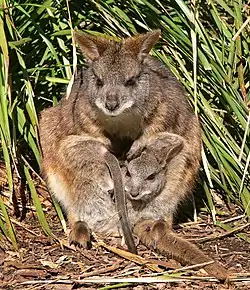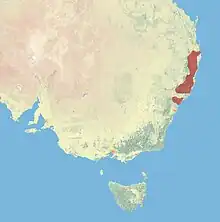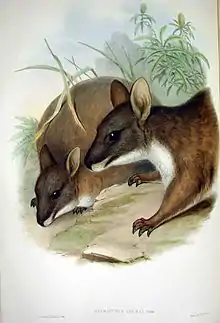Parma wallaby
The parma wallaby (Notamacropus parma)[2] is a small, hopping, kangaroo-like mammal native to forests of southeastern Australia. About the size of a stout cat, it lives in dense shrub and is only active at night to feed on grasses and small plants. It is the smallest of the wallabies (short, kangaroo-like animals of the genus Notamacropus) and carries its young in a pouch like other marsupials. Shy and elusive, it was believed extinct until rediscovery in the 1960s. It is threatened by habitat loss and is easily killed by non-native foxes.[1]
| Parma wallaby | |
|---|---|
 | |
| Scientific classification | |
| Domain: | Eukaryota |
| Kingdom: | Animalia |
| Phylum: | Chordata |
| Class: | Mammalia |
| Infraclass: | Marsupialia |
| Order: | Diprotodontia |
| Family: | Macropodidae |
| Genus: | Notamacropus |
| Species: | N. parma |
| Binomial name | |
| Notamacropus parma (Waterhouse, 1845) | |
 | |
| Parma wallaby range | |
| Synonyms[1] | |
|
Macropus parma Waterhouse, 1845 | |
Taxonomy
The parma wallaby was first described by British naturalist John Gould in about 1840. Its epithet parma (Waterhouse 1845) comes after a word from a New South Wales Aboriginal language, but the exact source word and language have not been identified.[3]
In 2019, a reassessment of macropod taxonomy determined that Osphranter and Notamacropus, formerly considered subgenera of Macropus, should be moved to the genus level.[4] This change was accepted by the Australian Faunal Directory in 2020.[5]
Rediscovery and sightings
A shy cryptic creature of the wet sclerophyll forests of northern New South Wales (Australia), it was never commonly encountered and, even before the end of the 19th century, it was believed to be extinct.
In 1965 workers on Kawau Island of New Zealand (near Auckland), trying to control a plague of introduced tammar wallabies (a widespread and fairly common species in Australia), were astonished to discover that some of the pests were not tammar wallabies, but a miraculously surviving population of parma wallabies - a species long thought extinct. The extermination effort was put on hold while individuals were captured and sent to institutions in Australia and around the world in the hope that they would breed in captivity and could eventually be reintroduced to their native habitat.
The renewed interest in the parma wallaby soon led to another milestone: in 1967 it was found that they still existed in the forests near Gosford, New South Wales. Further investigation showed that the parma wallaby was alive and well, and although not common, was to be found in forests along the Great Dividing Range from near Gosford almost as far north as the Queensland border.
The offspring of the Kawau Island population are smaller than their fully wild relatives, even when provided with ample food: it appears that competition for limited food resources on the island selected for smaller individuals, an incipient example of the phenomenon of insular dwarfism.
Description
The parma wallaby is the smallest member of the genus Notamacropus, at between 3.2 and 5.8 kg (7.1 and 12.8 lb), less than one-tenth the size of the red kangaroo. It is about 0.5 m (1.6 ft) in length, with a sparsely furred, blackish tail about the same length again. The fur is a reddish or greyish brown above, greyer about the head, and fading to pale grey underneath. Presumably, individuals had been sighted many times during the years when it was "extinct", but mistaken for an especially slender and long-tailed example of the otherwise similar red-legged and red-necked pademelons.
Habitat and behavior

The Parma wallaby inhabits wet sclerophyll (hard-leaved) forests of northern New South Wales, Australia. Like the pademelon, it prefers forest with thick undergrowth, and grassy patches, although parma wallabies are also found occasionally in dry eucalypt forest and even rainforest. It is mainly nocturnal and usually shelters in thick scrub during the day, through which it can travel at speed along the runways it makes. It emerges from cover shortly before dusk to feed on grasses and herbs in forest clearings. The parma wallaby is largely solitary, with two or at most three animals sometimes coming together to feed in favourable circumstances.
Status
The species remains rarely seen, with some evidence for a recent population decline. It is classified as Near Threatened according to the 2015 IUCN assessment.[1]
References
- Lunney, D.; McKenzie, N. (2019). "Notamacropus parma". IUCN Red List of Threatened Species. 2019: e.T12627A21953067. doi:10.2305/IUCN.UK.2019-1.RLTS.T12627A21953067.en. Retrieved 19 February 2022.
- "Notamacropus parma". ASM Mammal Diversity Database. 1.5. American Society of Mammalogists. Retrieved 23 September 2021.
- Nash, David (2014). "Reviving unique words: The niche of scientific names". In Zuckermann, Ghil’ad; Miller, Julia; Morley, Jasmin (eds.). Endangered Words, Signs of Revival. AustraLex. p. 1.
- Celik, Mélina; Cascini, Manuela; Haouchar, Dalal; Van Der Burg, Chloe; Dodt, William; Evans, Alistair; Prentis, Peter; Bunce, Michael; Fruciano, Carmelo; Phillips, Matthew (28 March 2019). "A molecular and morphometric assessment of the systematics of the Macropus complex clarifies the tempo and mode of kangaroo evolution". Zoological Journal of the Linnean Society. 186 (3): 793–812. doi:10.1093/zoolinnean/zlz005. Retrieved 1 March 2020.
- "Names List for MACROPODIDAE, Australian Faunal Directory". Australian Biological Resources Study, Australian Department of the Environment and Energy. 13 February 2020. Retrieved 1 March 2020.
- Groves, C. P. (2005). Wilson, D. E.; Reeder, D. M. (eds.). Mammal Species of the World: A Taxonomic and Geographic Reference (3rd ed.). Baltimore: Johns Hopkins University Press. p. 65. ISBN 0-801-88221-4. OCLC 62265494.
- Strahan, R., ed. (1983). The Australian Museum Complete Book of Australian Mammals. Angus and Robertson. ISBN 9780207144547. OCLC 607207770.
External links
- Photos at ARKive
- The Aussie Parma Wallaby Ark Conservation Project
- "Notamacropus parma (Waterhouse, 1845) – Parma Wallaby". Atlas of Living Australia.
